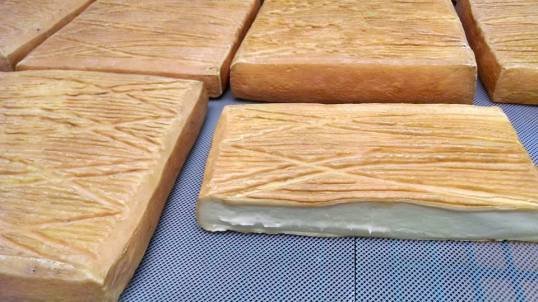I was looking up information about probiotic diets one afternoon when I came upon the Wikipedia page for Skin Flora and an image on the page caught my eye. It was an image of a man and the types of bacteria that grow on skin on different parts of the body. One of the types of bacteria was familiar — it was the same type we put in the milk to make our washed rind, Tobasi!
Corynebacteriae. It’s in the crevice of your nose, in your groin (inguinal crease), your belly button (umbilicus), and your “toe web space.” It’s also what contributes to the beige-red color (Law, Tamime) of the rind of washed rind or smear-ripened cheeses.
While in utero, a human fetus is sterile. It is not until the mother’s water breaks and the baby is being pushed through the birth canal that bacteria is introduced to the baby’s skin. Later, handling and feeding the newborn will contribute to the bacterial population and while we’ve established most of our bacteria in the first 48 hours of our life, our environment will continue to shape us.
Smear-ripened cheese requires a lot of different kinds of microbes for flavor, color, and rind and paste development. (gooey texture? caused by microbes!) Microbes are purposefully added to the milk during the cheesemaking process and/or colonize the cheese from ambient air. You may call cheesemakers the mothers of the cheeses we make 🙂
Due to lactic acid in sweat and produced by skin bacteria, superficial layers of the skin are naturally acidic (pH 4-4.5) . At this pH mutualistic flora such as Staphylococci, Micrococci, Corynebacterium and Propionibacteria grow (Lambers et al.) (Some of you turophiles may find that last one familiar as well). This is about the same pH that we want our Tobasi, our washed-rind cheese, to be when it is ready to be put in the aging room to begin rind development so the rind is hospitable to grow the desired bacteria.
But no, they are not the same bacteria. Same genus, different species.
According to one study done on dogs, (who seem to have similar corynebacteria species as humans) skin harbors Corynebacterium humireducens, Corynebacterium diphtheriae, Corynebacterium pseudotuberculosis and Corynebacterium ulcerans. (Frischmann et al.) and Corynebacterum Casei grows on cheese. How closely related are they? Check out the phylogenetic tree below —
When selling cheese people inevitably ask me what the rind is made of and if can they eat it – a valid question and one that I delight in answering. Upon hearing the answer many people cannot keep from wrinkling up their nose when they hear that the rind is bacteria (or mold). But it’s all over you too, microbeface!
According to an article that a friend sent me about making cheese from the bacteria on human bodies, scientists found that “about 25 percent of the fungi and 60 percent of the bacteria found in these microbial cheese communities were not those introduced by the cheesemakers to create the cheese.” – but where did these bacteria come from? (Fessenden)
“Some may have washed in with the salty brine used to age the cheese. Others were present in the milk itself. Still others may have come from the cheesemaker’s hands. Yup, eating “normal” cheese already includes microbes that live on humans.” ~ Christina Agapkis, microbiologist UCLA
It seems that you truly are what you eat!
Bibliography
Marissa Fessenden. How to Make Cheese Using the Microbes on your Feet. The Daily Dot. July 22, 2014 Last Accessed: 08/02/2014 http://www.dailydot.com/geek/foot-bacteria-cheese-project/
Kenneth Todar, pHD. The Normal Bacteria Flora of Humans (page 3). Todar’s Online Textbook of Bacteriology. 2008-2012 Last Accessed: 08/02/2014 http://www.textbookofbacteriology.net/normalflora_3.html
Djossou F, Bézian MC, Moynet D, Le Flèche-Matéos A, Malvy D. Corynebacterium mucifaciens in an immunocompetent patient with cavitary pneumonia. BMC Infect. Dis. (2010) Last Accessed: 08/02/2014 http://openi.nlm.nih.gov/detailedresult.php?img=3009641_1471-2334-10-355-3&req=4
Get Culture. Corynebacteria. (2012) Last Accessed: 08/02/2014 https://www.getculture.com/Corynebacteria/
H. Lambers, S. Piessens, A. Bloem, H. Pronk and P. Finkel. Natural skin surface pH is on average below 5, which is beneficial for its resident flora. International Journal of Cosmetic Science. Volume 28, Issue 5, pages 359–370, October 2006. Last Accessed: 08/02/2014 http://onlinelibrary.wiley.com/doi/10.1111/j.1467-2494.2006.00344.x/abstract;jsessionid=53C216F0A3096869D93068A3F8C3263B.f02t03
Darryl Leja. Skin Microbiome. National Human Genome Research Institute. Last Accessed 08/02/2014: http://www.genome.gov/dmd/img.cfm?node=Photos/Graphics&id=85320
Barry A. Law, A. Y. Tamime eds. Technology of Cheesemaking 2nd ed. Wiley-Blackwell. Last Accessed 08/02/2014 http://books.google.com/books?id=Turm77IMxnUC&pg=RA1-PT156&lpg=RA1-PT156&dq=Corynebacteriae+cheese&source=bl&ots=r6xrF3gyp0&sig=9gfU0WI_lWT9-YzgiKN5GSEC5rE&hl=en&sa=X&ei=dBDUU5KPKZSyyASZv4DYBQ&ved=0CEgQ6AEwBw#v=onepage&q=Corynebacteriae&f=false
Patrick F. Fox, Paul L. H. McSweeney, Timothy M. Cogan, Timothy P. Guinee eds. Cheese: Chemistry, Physics, and Microbiology: General Aspects, 3 ed. Vol. 1. 2004 Elsiver. Last Accessed 08/02/2014: http://books.google.com/books?id=a95C5Nza5_EC&pg=PA197&lpg=PA197&dq=Corynebacteriae+cheese&source=bl&ots=dhTBgImeTz&sig=e34ORx1DYYP6ATlaA5Q6J5DXTl4&hl=en&sa=X&ei=dBDUU5KPKZSyyASZv4DYBQ&ved=0CEoQ6AEwCA#v=onepage&q=Corynebacterium&f=false
Frischmann A, Knoll A, Hilbert F, Zasada AA, Kämpfer P, Busse HJ. Corynebacterium epidermidicanis sp. nov., Isolated from Skin of a Dog. Int J Syst Evol Microbiol. 2012 Sep;62(Pt 9):2194-200. doi: 10.1099/ijs.0.036061-0. Epub 2011 Nov 11. Last Accessed 08/02/2014 http://www.ncbi.nlm.nih.gov/pubmed/22081710




